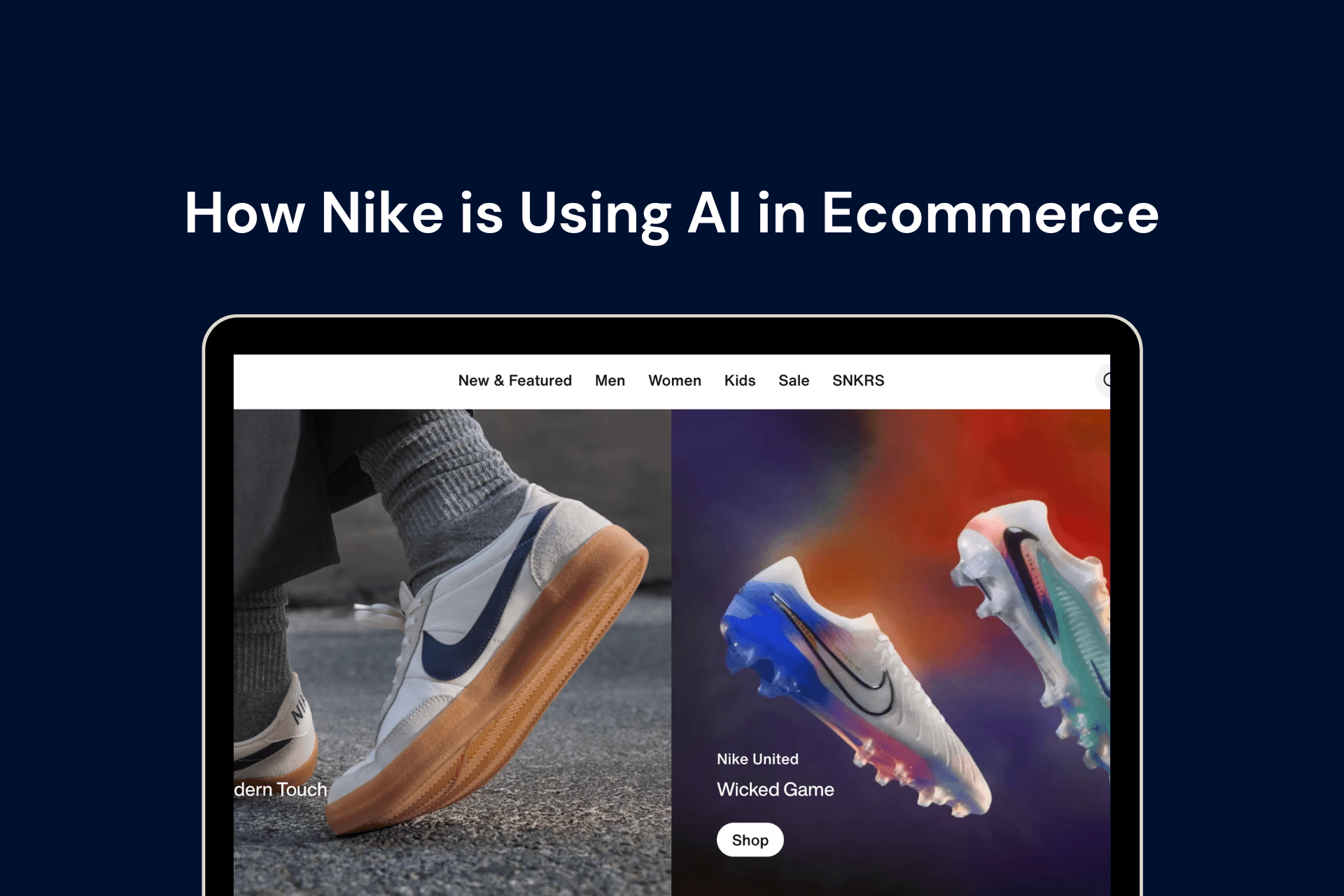Nike leverages AI for personalized recommendations, Nike Fit AR sizing, chatbots, predictive marketing, and supply chain optimization - key strategies any ecommerce brand can adapt to boost sales and reduce returns.
Nike is the strongest sports apparel brand in 2025, according to research by Brand Finance. But apart from its product quality, design, and appeal to fitness enthusiasts, there’s more that the brand puts into its brand presence.
This brings us to Nike’s AI eCommerce strategy across its channels and processes. From marketing to inventory management to customer support, Nike intelligently uses AI and ML.
In this blog, we learn how the brand uses AI and how you can implement it in your Shopify store.
Key AI Strategies Nike Uses to Transform Ecommerce
-
Nike has built a comprehensive AI eCommerce strategy that goes far beyond basic automation.
-
Nike’s AI eCommerce strategy enables personalized shopping with machine learning algorithms analyzing browsing patterns, purchases, and preferences to deliver tailored product recommendations that increase engagement and conversions.
-
With smart sizing solutions, such as Nike Fit, the brand uses AR/VR technology to scan feet and capture 13 data points, providing accurate size recommendations that reduce returns and boost customer confidence.
-
Nike’s 24/7 AI support offers natural language processing chatbots that handle customer queries across all channels in real-time, seamlessly transitioning to human agents when needed.
-
For predictive operations, the brand uses AI-driven analytics to optimize marketing campaigns, forecast demand, and streamline supply chains - cutting logistics costs by 5-20% while keeping popular items in stock.
-
Nike’s AI eCommerce continuously evolves as A/B testing and ML models constantly analyze user interactions to optimize every aspect of the platform, ensuring Nike stays competitive as customer preferences and technologies evolve.
Nike’s Holistic AI eCommerce Strategy
According to a Forbes study, AI’s potential for eCommerce is more than just content creation. It stretches to predictive inventory, smart shelving, demand forecasting, and loss prevention, among other benefits. And that’s something we can learn from Nike’s AI eCommerce strategy.
Nike doesn’t just use technology for namesake; the brand implements various artificial intelligence (AI) systems and tools for a thorough digital commerce experience.
Nike’s AI eCommerce systems use algorithms for personalization and customization. For example, it uses conversational AI to help customers find products they’re looking for. So if a customer searches for “running shoes red”, the AI product tagging tools share products that are tagged racing shoes, scarlet shoes, training shoes, etc.
Nike’s virtual shopping assistance and AI customer support help customers 24/7 by answering queries, help finding desired products, and more. Nike also has computer vision and 3D scanning technology to provide accurate recommendations for shoe sizes. Meanwhile, the brand also uses tools to enable customization with its Nike By You program.

The brand enhances engagement and loyalty using data analytics from their apps connected to performance apps, such as Fitbits. It understands user habits and forecast buying decisions using predictive analytics.
A Breakdown of Nike’s AI eCommerce Strategy
From customer-facing product recommendations to backend operations, Nike employs AI tools for various processes. That’s how it maintains its position as one of the best sports brands in the world. Apart from its products, the brand’s eCommerce and digital experience is on top. Here’s a breakdown of how Nike uses AI in eCommerce across its channels.
1. Machine learning for personalized recommendations
As soon as a visitor or customer starts browsing the Nike website, its machine learning algorithms get to work. The ML systems analyze data, such as past and current browsing patterns, past purchases, wishlists, cart abandonment patterns, the amount of time spent browsing product pages, etc. From this data, AI understands individual preferences and then shapes product recommendations that are of relevance.
For example, if a visitor browses tennis shoes often, the AI system recommends related products, or highlights a tennis shoe that is available on discount, or new collections from the tennis section. Moreover, AI considers more details, such as the preference for color, style, price range, etc., to narrow down recommendations to make them more relevant.
How this helps:
-
It provides a deeper personalized experience
-
It creates a curated shopping experience that is relevant
-
It avoids overwhelming customers with thousands of irrelevant products
-
Improves engagement rate, conversions, and customer satisfaction

2. Virtual try-on technology via AR and VR
The augmented reality (AR) market was valued at $40.12 billion in 2022. It is projected to reach $1.9 trillion by 2032. Nike has implemented Nike Fit, a virtual try-on technology. The system helps the brand tackle one of the most common challenges of eCommerce - sizing.
Nike Fit uses AR and virtual reality (VR) to enable customers to scan their feet using a smartphone camera. It creates precise 3D measurements that provide optimal fit recommendations. The technology captures 13 data points from each foot. With this information, the system matches Nike’s products on the website and shares recommendations.
How it helps:
-
Reduces sizing-related returns
-
Increases conversions because customers buy with a little more confidence
-
Enhances customer satisfaction levels
-
Provides an interactive shopping experience

3. AI-powered virtual customer support
Nike employs natural language processing and conversational AI into its digital platforms for enabling intelligent virtual assistance to customers. The AI-based chatbots handle various queries in real-time.
For example, say a customer is shopping for training wear and has sizing queries. Instead of calling a live agent, Nike’s chatbot shares information with the customer.
Nike’s AI eCommerce chatbots can handle various queries, including product details, delivery information, returns policy, and other shopping assistance.
Here’s how it helps:
-
Nike’s virtual assistance have the ability to understand context and maintain conversational flow
-
The system’s AI-based tools use natural language to interpret customer intent
-
Nike’s AI eCommerce tools function across channels - website, mobile app, and social media
-
Ensures consistent support to customers
-
When queries require human intervention, the AI tool transitions to live agents

4. Predictive analytics for dynamic marketing
Nike implements predictive analytics tools for its marketing campaigns and personalized content. Nike’s AI eCommerce systems analyze customer behavioral data, demographic information, interests, engagement patterns, and more, to create a detailed customer profile.
Predictive analytics models also create forecasts for future actions. With this, Nike creates and optimizes promotional messages, creates personalized content, and more. This helps with marketing campaigns, making them more relevant to customers.
Here’s how it helps:
-
Enhances and evolves marketing strategies continuously based on updated data
-
When certain messages work well, AI doubles down, adjusts future campaigns
-
When campaigns do not bring results, predictive analytics tools identify issues and optimize
-
It helps the brand maximize its marketing spends

5. Supply chain optimization
Using AI, ML, and predictive analytics for supply chain related functions can help brands reduce 5% to 20% logistics costs, and 5% to 15% in procurement costs. Nike’s AI eCommerce strategy involves tools for supply chain management.
But how does it work? ML models use sales data, seasonal sales trends, social media sentiment, and external factors, such as weather and market economic trends, to predict product demand.
With these insights, Nike optimizes its inventory levels across its distribution network. Thus, the brand’s popular items always remain in stock, and there’s less overproduction of slow-moving products.
Here’s how it helps:
-
Optimizes logistics operations by identifying efficient shipping routes, warehouse allocation, and fulfilment strategies
-
Predicts order volumes and identifies possible bottlenecks
-
Maintains fast delivery and reliable service
-
Enhances customer experience
6. Continuous optimization
Being one of the biggest sport brands, Nike’s AI eCommerce platforms consistently evolve and optimize. Nike implements A/B testing to consistently improve user interface, customer journeys, and overall performance.
Nike’s ML models analyze how customers interact with different design elements, navigation routes, checkout flows, etc. This continuous analysis helps identify optimization opportunities.
For instance, the testing system functions at scale by simultaneously evaluating multiple variables across different customer segments. AI detects subtle patterns, recognizes combinations that work, etc. For example, if the AI system detects that some customers prefer mobile shopping over web, it shares more recommendations and promotional messages over the app for that customer.
Here’s how it helps:
-
Nike’s digital platforms are always up to date and optimized
-
Every aspect of the platforms are evaluated and improved
-
The website evolves as customer preference evolves and new technologies get introduced
-
Nike’s AI eCommerce tools ensure the brand remains competitive and intuitive

Wrapping up: Do you want to Employ AI in your Shopify Store the way Nike does?
Nike’s AI eCommerce strategy offers many lessons and takeaways which you can implement in your Shopify store. However, AI transformation is not an easy process, as brands could end up making many mistakes.
Not knowing how to implement, which tools to invest in, and going all out starting everything in one go can backfire when implementing AI in your Shopify store.
That is why it is essential to partner with AI agencies and Shopify retainers that can help you implement, manage, and optimize your Shopify AI infrastructure. XgenTech can help you identify key areas where you can implement AI, tools you should invest in, maintain your AI systems, and get the most ROI from AI.
Contact XgenTech’s AI experts to understand how we can help.
FAQs About Nike’s AI Ecommerce Strategy & Shopify Implementation
1. What AI features does Nike use in ecommerce?
Nike uses ML for personalization, AR (Nike Fit) for sizing, NLP chatbots, predictive analytics for marketing and inventory, and automated A/B testing to optimize UI and flows.
2. Does Nike’s AI actually reduce returns?
Yes - tech like Nike Fit reduces size-related returns by improving fit accuracy (AR/3D measurements); industry studies show notable return reductions when sizing tools are used.
3. What’s a quick AI win for a small Shopify store?
Start with AI product recommendations and personalized email automation (3rd-party apps) - low cost with fast conversion improvements.
4. Which Shopify apps help replicate Nike-like personalization?
Look for AI product-recommendation apps, AI product tagging tools, and recommerce/size-fit widgets. (Add specific app names you recommend here.)
5. How do I measure ROI from AI investments?
Track conversion rate lift, average order value (AOV), return rate, repeat purchase rate, and customer LTV before/after deployment.
6. Is customer data privacy a concern with AI?
Yes. Use first-party data, be transparent in your privacy policy, and comply with regional laws (GDPR, CCPA). Anonymize and aggregate where possible.
7. Can AI improve supply chain decisions for small brands?
Yes - forecast models that use sales, seasonality and promo calendars can optimize small-scale inventory and reduce stockouts.
8. How often should ML models be retrained?
Depends on traffic/volume - weekly for active catalogs and monthly for smaller shops; always track model drift.
9. Do I need data scientists to start?
No. Many SaaS AI tools provide out-of-the-box models; teams can partner with consultants for orchestration and advanced use cases. (Link to your Shopify AI Consultant service).
10. How do you A/B test AI-driven experiences?
Use holdout groups and multi-armed bandit testing, measure persistent metrics (LTV, return rate) and guard for personalization bias.




